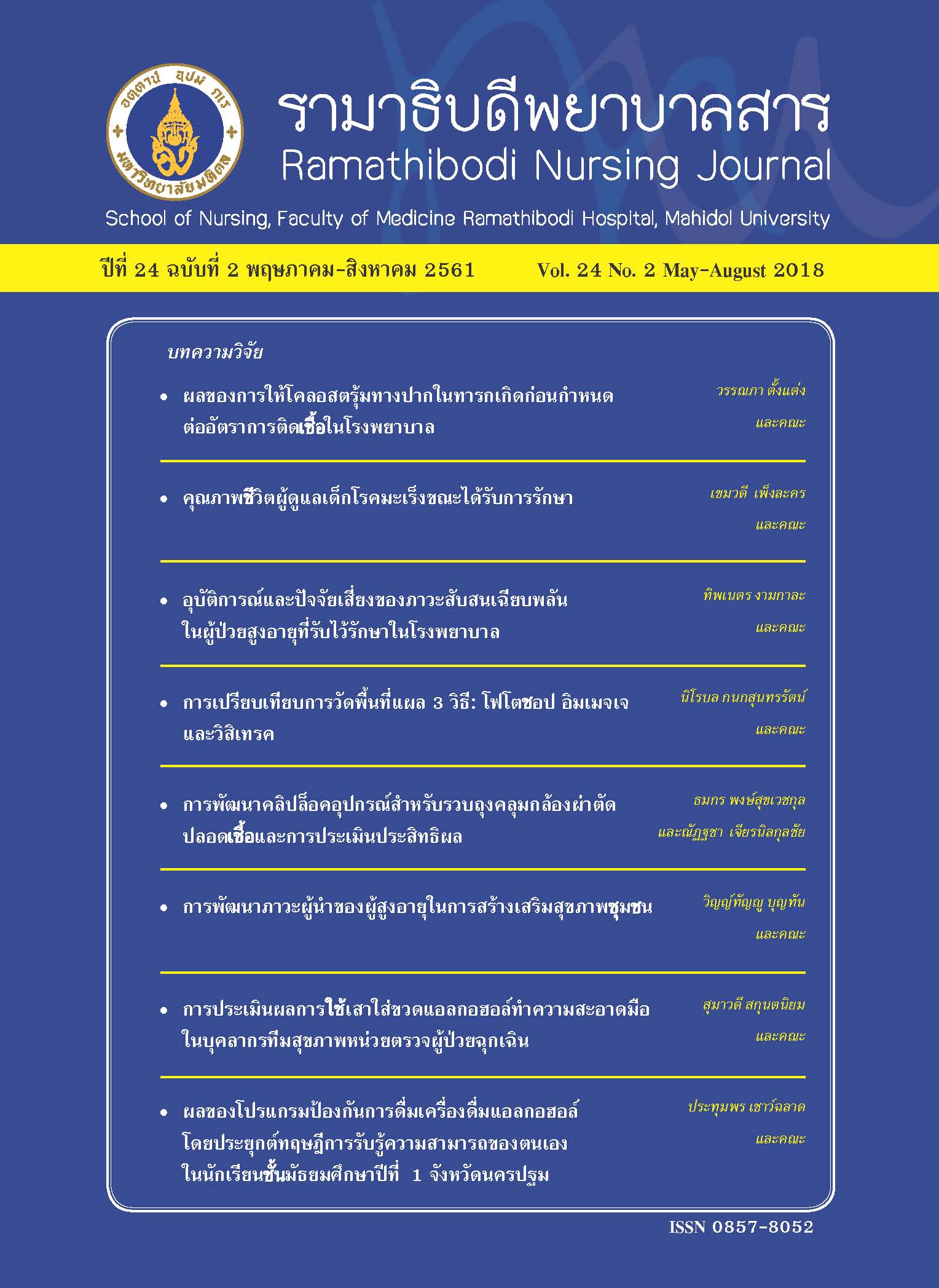Evaluation of Using Alcohol-Based Hand Rub Bottle Holders for Hand Hygiene among Healthcare Personnel in an Emergency Unit
Main Article Content
Abstract
Abstract
Performing hand hygiene to minimize the number of pathogenic
microorganisms on healthcare personnel’s hands can reduce the risk of interpersonal
spreading of the organisms among patients and healthcare personnel. The purpose of
this study was to explore the hand hygiene adherence among healthcare personnel in an
emergency unit of Ramathibodi Hospital at 3 months pre- and post-installation of the
alcohol-based hand rub bottle holder, and to evaluate their satisfaction with this invention.
A total of 170 healthcare personnel participated in this study. The instruments consisted
of a questionnaire about satisfaction with using alcohol-based hand rub bottle holders,
and an observation form of hand hygiene of healthcare personnel while working.
Descriptive statistics were used to analyze the data. The results revealed that 85.71%
of the sample were satisfied with the invention in overall as the high- and highest level,
and 86.51% agreed that using this invention helps them promote more hand hygiene
activities. The hand hygiene adherence rate significantly increased from 19.65% to
59.05%. This study demonstrated that providing easy access to alcohol hand rub is an
important factor that can significantly increase hand hygiene adherence.
Keywords: Hand hygiene, Alcohol-based hand rub bottle holder, Invention, Healthcare personnel
Article Details
บทความ ข้อมูล เนื้อหา รูปภาพ ฯลฯ ที่ได้รับการตีพิมพ์ในรามาธิบดีพยาบาลสาร ถือเป็นลิขสิทธิ์ของวารสาร หากบุคคลหรือหน่วยงานใดต้องการนำทั้งหมดหรือส่วนหนึ่งส่วนใดไปเผยแพร่หรือเพื่อกระทำการใด ใด จะต้องได้รับอนุญาตเป็นลายลักษณ์อักษรจากรามาธิบดีพยาบาลสารก่อนเท่านั้น
References
2006. Clean care is safer care. Geneva: WHO Document Production Services; 2006.
2. Punjapiyakul P. National patient safety goal 2007-2008. Nonthaburi: Health Service Support Department; 2550.
(in Thai)
3. Apivanich S. Nursing for prevention and infection control. In: Senadisai S, ArpanantikulM, editors. Handbook of
nursing practice. Bangkok: Judthong; 2009. p.78-87.(in Thai)
4. World Health Organization (WHO). WHO guidelines on hand hygiene in health care. Geneva: WHO Document
Production Services; 2009.
5. Bischoff WE, Reynolds TM, Sessler CN, Edmond MB,Wenzel RP. Hand washing compliance by health care
workers: the impact of introducing an accessible, alcoholbased hand antiseptic. Arch Intern Med. 2000;160:1017-
21.
6. Paotong D, Trakarnchansiri J, Phongsanon K, Churncharoen P, Sitaphong S, Poldee T, et al. Compliance with
handwashing in a university hospital in Thailand. Am J Infect Control.2003;31:128.
7. Picheansathian W, Pearson A, Suchaxaya P. The effectiveness of a promotion programme on hand hygiene
compliance and nosocomial infections in a neonatal intensive care unit. Int J Nurs Pract. 2008;14:315-21.
8. Pittet D. Improving compliance with hand hygiene in hospitals. Infect Control Hosp Epidemiol. 2000;21:381-6.
9. Rosenthal VD, McCormick RD, Guzman S, Villamayor C, Orellano PW. Effect of education and performance
feedback on handwashing: the benefit of administrative support in Argentinean hospitals. Am J Infect Control.
2003;31:85-92.
10. Bunnag M. Statistics for research and decision making. 7th ed. Bangkok: Chulalongkorn University Printing House;
2008.(in Thai)
11. Muller MP, Carter E, Siddiqui N, Larson E. Hand hygiene compliance in an emergency department: the effect of
crowding. Acad Emerg Med. 2015;22:1218-21.
12. Hitoto H, Kouatchet A, Dubé L, Lemarié C, Mercat A,Joly-Guillou ML, et al. Factors affecting compliance with
glove removal after contact with a patient or environment in four intensive care units. J Hosp Infect. 2009;71:
186-8.
13. Pittet D, Hugonnet S, Harbarth S, Mourouga P, Sauvan V, Touveneau S, Perneger TV. Effectiveness of a hospitalwide programme to improve compliance with hand hygiene. Infection Control Programme. Lancet.
2000;356:1307-12.
14. Girou E, Chai SH, Oppein F, Legrand P, Ducellier D,Cizeau F, et al. Misuse of gloves: the foundation for poor
compliance with hand hygiene and potential for microbial transmission. J Hosp Infect. 2004;57:162-9.
15. Fuller C, Savage J, Besser S, Hayward A, Cookson B, Cooper B, Stone S. “The dirty hand in the latex glove”: a
study of hand hygiene compliance when gloves are worn.Infect Control Hosp Epidemiol. 2011;32:1194-9.
16. Venkatesh A, Pallin D, Crim H, Pandya D, Rosborough S, Villarreal R, et al. Environmental predictors of hand
hygiene compliance in the emergency department. Ann Emerg Med. 2009;54: 76-7.


